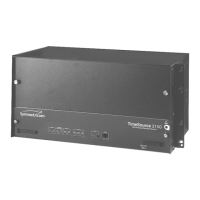Chapter 1 Overview of the TimeSource 3100
Functional Description
22 TimeSource 3100 User’s Guide 097-72020-01 Revision K – December 2005
Antenna
The antenna housing includes a volute antenna, GPS receiver, amplifier, and
intermediate-frequency (IF) downconverter.
The GPS Receiver extracts a clock signal from the GPS satellite signals. The
receiver can process the signals from all satellites in view, while simultaneously
using the Earth location of the receiver and other factors to determine an accurate
clock signal.
An amplifier in the antenna provides 23 dB of signal gain.
A downconverter converts the L-band GPS signal to IF for long-distance transport
on the coaxial antenna cable. The antenna cable provides 125 mA power from the
shelf to the antenna, and transports GPS satellite IF signals from the antenna to the
shelf.
IF Interface
An IF interface accepts the signals from the antenna, and provides the clock
information to the BesTime Ensemble Timing Generator.
Local Oscillator
A digitally controlled, oven-controlled crystal oscillator (OCXO) develops a highly
stable local oscillator signal, independent of factors that exist outside the shelf. This
signal is sent to the BesTime Ensemble Timing Generator.
Clock Extractors
A clock extractor circuit extracts a timing signal from each external reference source
(External sources, other than the GPS antenna, are optional). The extracted timing
signal is sent to the BesTime Ensemble Timing Generator.
Power Supply
A power converter filters and converts -48 volts dc power supplied to the shelf into
the voltages required by the shelf.
NTP TimeServer
The TimeServer is a Simple Network Time Protocol (SNTP) device. The SNTP
TimeServer function is provided via the TimeSource Ethernet interface and
associated IP address. User software requests UTC time of day via NTP protocol.
The TimeSource SNTP server responds with current UTC time. The TimeServer is
compatible with the SNTP RFC-1769 format.

